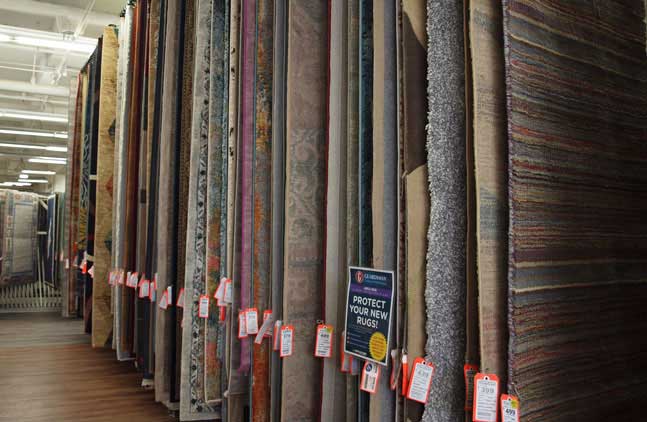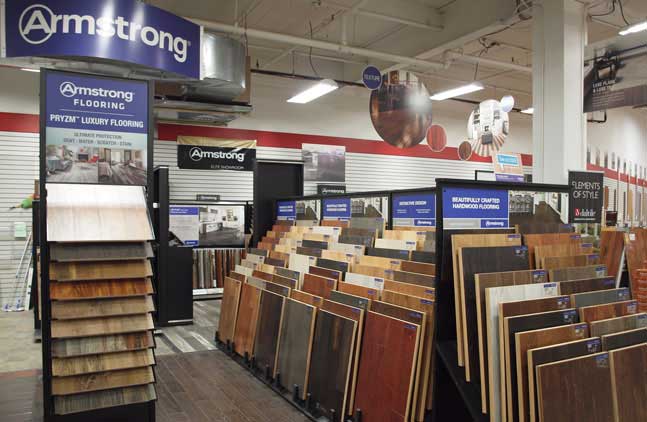How To Choose The Right Rug
Posted by Ben Garelick (@BlueShirtBenny) on 1st Oct 2024
Rugs have an amazing power to tie a room together. They can add a layer of coziness, sophistication, or modernity to your space–it all depends on your style. There are tons of materials, colors, and patterns to choose from, though, so how do you pick the perfect rug for your space with so many options?
The key to picking out the right rug is to consider your space and style goals. Will your rug be going into a large living room? Are you using the rug to tie together different style elements from around the room? Questions like these will help you determine what rug will work best for your home.
We'll go over the main factors you should consider as you shop for a new rug, including size, shape, color, material, and overall interior design. Whether you're looking for colorful rugs to reflect the maximalist style in your home or you would like modern classic rugs that are easy to keep clean with the pets in your house, we'll guide you through selecting the perfect ones for your home.
Choosing the Best Rug for Your Home
Before you start shopping for rugs, it's a good idea to think about the purpose of the rug and your overall interior design style. You want to make sure that the rug will be practical and functional in the room where it will be placed. Considering things like foot traffic, pets, kids, and furniture will help determine what rug will best suit your needs.
For example, going with a delicate and expensive vintage rug in a high-traffic area, like your living room, is probably not the best idea, especially if you have kids or pets. In addition to the practical purposes of the rug, you should also consider the aesthetics of your space. You'll want to choose a rug that fits the overall style of the space and existing furniture. Choosing a rug that clashes with the rest of the room will be an eyesore.
Think About the Dimensions of Your Space
The first thing to consider when picking out a new rug is the space where it will be placed. Having a tiny rug in a large living room will look odd. In the same way, a large rug in a room will overcrowd the space and make it look cramped.
Size and Shape
When thinking about a new rug, there are a few practical questions you'll need to consider before looking at style. The first question is, what room is the rug going to be placed in? The other question is, what is the shape of the space?
Living rooms generally require a large rug than other rooms. Rugs should be big enough to cover the main features of the room, like your sofa, coffee table, and chairs. But not so big that there's no space between the wall and the rug.
In a dining room, the same size principles as the living room apply. The rug should comfortably fit your table and chairs (even when pushed away from the table). There should be enough space to show the floor underneath along all of the walls too.
However, the bedroom is a bit looser on sizing issues. If you have a large bedroom with the appropriate amount of space for a big rug, then aim to cover all of your main bedroom furniture (bed and side tables). A lot of bedrooms simply don't have enough space for this size of a rug, though. In that case, using smaller rugs along the sides of your bed will suffice. Also, layering a portion (about ⅓) of the rug under your bed is a good way to place it in a smaller room.
Some spaces of the home will require runner rugs, like kitchens, hallways, or entryways. Narrow or small rugs will work the best in these types of spaces as they won't take up too much space in already tight pathways.
How to Measure a Room for a Rug
Figuring out where you want your rug to be placed can be difficult. One of the easiest ways to visualize the space is by measuring out painter's tape and placing it on the floor where you want your rug to sit.
Consider Your Existing Furniture
When choosing area rugs for your living room, dining room, or bedroom, it's important to consider the furniture in the space. You should make sure that the rug properly fits with your existing furniture spatially as well as stylistically.
For living rooms, you'll often place area rugs underneath the main sitting area, typically the sofa and armchairs. In bedrooms, often, the size of the room will be too small to fit a large rug that covers your whole bed. In that case, you may want to opt for smaller rugs placed strategically under a portion of the furniture.
In terms of style, unless you are picking out area rugs rug before you've bought any furniture, you'll need to pick a style that matches or complements the furniture you already own. Buying whole new furniture to match your rug would be expensive and time-consuming. So it's helpful to think about how your rug will look paired next to your furniture.
Pick Out the Right Color Palette and Pattern
Colorful rugs are a great way to add dimension and interest to a space. It adds a layer of design to your room and can tie the whole space together. That's why picking out the color and design of the rug is a crucial part of the rug shopping process. Whether you're looking for modern classic rugs or colorful rugs to brighten up your space, thinking about the color palette for the entire room is essential.
There are some common rug designs out there, including
- Persian
- Moroccan
- Southwest
- Geometric
- Modern
- Farmhouse
- Animal-print
- Coastal
- Vintage
If you're having trouble figuring out which rug designs will work best in your space, it's helpful to consider the color palette first. If your space would work well with a pop of color, consider colorful rugs that have a bright base color. A solid-colored rug without any fancy design would also work.
If you're interested in exploring your style and mixing up the design elements of the room, it might be a good idea to mix and match rug designs throughout your home. Modern classic rugs may look incredibly inviting and relaxing in your bedroom, but your living room might benefit from a traditional and intricate Moroccan rug to balance out the rest of the design elements in the room.
Whatever your interior design style is, area rugs can bring personality to a room. Even if you prefer a neutral color scheme, adding a neutral-colored rug with a pattern can bring some much-needed visual drama to the room.
Tips for Selecting Colors and Patterns
The colors of your wall and floors have a huge impact on the rest of your room. Whether you're working with a tiny room or a large one, color can change the overall vibe of your space. That's why choosing the right color rug is one of the best ways to tie a room together.
Choosing the color and pattern of your rug can be a practical choice as well as an aesthetic one. If you have children or pets, you probably have to deal with stains and messes regularly. Patterned dark-colored rugs may be a good option if you want to hide stains or discoloration easily.
If you have a room that's a jumble of different styles or colors, you may want to consider a neutral rug. A simple solid color or a neutral pattern can provide a solid base for the eclectic style of the rest of the room.
Another option for rooms that have an eclectic feel to them is to pick a rug with one or two colors already found in the room. This will help to tie different decor elements from around the room together. For example, if your couch is orange and you have a large painting that is predominantly red, then you can incorporate those colors into the rug to make the room seem more cohesive.
Choosing Materials and Style
Along with the color palette and design, you should consider the material of the rug. While this may not seem as important as the appearance of the rug, in a practical sense, the material will determine the overall durability and functionality the piece will have in your home.
For example, in high-traffic areas like the living room, you should make sure that the rug will be comfortable and able to handle a lot of use. If you're looking for a rug to place in the kitchen, your needs are going to be slightly different. Though you will still need a rug that can withstand heavy foot traffic, you'll need to get one that can be easily cleaned. With cooking splatters and food crumbs, you'll need a carpet that doesn't collect debris and resists stains.
Natural fibers (cotton, silk, wool, etc.) are trickier to clean, though they are expensive and high-quality. These would typically be placed in areas like the bedroom or other low-traffic areas of your home.
Synthetic fibers, on the other hand, are easier to keep clean. Most are usually stain-resistant and affordable, making them the perfect choice for high-traffic areas like kitchens, entryways, living rooms, and dining rooms.
Another consideration is the construction style of the fibers. Low-pile rugs refer to the short (or low) fibers of the rug. For this style of rug, you can expect small loops and short fibers that are packed tightly together. This style makes the rug easy to clean, as spills and debris won't get trapped in the fibers easily. If you're looking for rugs in high-traffic areas, then you should consider low-pile styles. They will ultimately save you a lot of time on cleaning and perhaps even money, as they will be easier to maintain long-term, so you won't have to buy a replacement.
High-pile rugs are the opposite of low-pile–think long and plush shag carpeting. Their tall fibers make them cozy and comfortable additions to spaces. However, these types of rugs are not easy to clean, so it's best to keep them out of high-traffic areas. If you're looking for a rug to place in your bedroom, a high-pile rug is a great choice. It can even work in your living room, provided that you don't usually eat or spill in the room often.
Rug Maintenance
Taking proper care of your rug is important in order to preserve its lifespan. It's recommended to clean your rug once every two years. However, if your rug sees a lot of traffic or stains, you might want to move up that date.
Overall, you should aim to clean up spills right after they happen, regardless of whether the material is stain-resistant or not. It's also good practice to vacuum regularly, even if you don't see dirt or debris.
Investing in a rug pad is an especially good idea for runners or small area rugs in the kitchen or entryway, but it can be useful for rugs anywhere in the house. They prevent bunches and wrinkles that happen from the rug slipping. They also prevent the rug from moving around on the floor, which happens quite a lot on slippery hardwood or tile floors.
Choosing a rug that fits your room's decor and that is practical to your lifestyle can seem challenging. But if you remember to think about the rug in terms of practicality and style, you can easily pick out a rug that ties your whole space together. Whether you're looking for colorful rugs to match a bohemian style or you need a vintage-looking rug that fits your farmhouse aesthetic, we carry a selection of rugs with many different styles and materials to choose from.
















